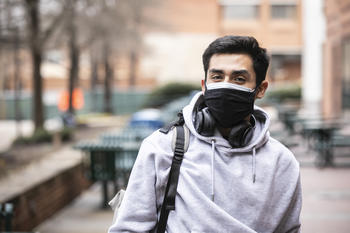Topics
In This Story

Infectious disease expert explains the differences between common types of face masks and how to wear them best to stay protected from COVID-19.
Amira Roess, professor in the Department of Global and Community, offers insight into practicing proper mask usage, such as identifying which masks are most effective in reducing the spread of COVID-19 and how long you should wear the masks before they are considered ineffective.
1. What type of face masks offers the best protection from COVID now that the omicron variant is dominant in the US?
A mask of three layers or more, a surgical mask, an N95, or a KN95 all offer good protection, provided that they fit well. That last part is what many people overlook. It is extremely important that the masks fit well. Gaps between the mask and the face may result in an opportunity for the virus to enter.
Two of the challenges that we have had throughout the pandemic is that many people did not wear their masks correctly or wore poor quality masks. The data have shown that the risk of infection decreases when wearing high-quality masks correctly and frequently. Masks are an important strategy in addition to vaccination, social distancing, testing, and isolating or quarantining as necessary.
2. What advice do you have for people who are shopping for face masks right now?
It is really important that individuals purchase masks that provide a good fit. We should also remember to follow the manufacturer's instructions and dispose of masks as instructed. Often masks are meant to be used for a certain number of hours and should be stored, following instructions, until either they have been used for the maximum hours or before that if they are soiled or worn out.
Many individuals report using disposable masks for longer than recommended by the manufacturer, and that leads to the masks being ineffective. Masks that end up being wet, dirty, torn, or that don't fit well should be disposed of properly. You can look for products that say they are ASTM level 1, 2, or 3 on the package. There is definitely a problem with counterfeit products, but if you look for this, you should be able to filter through and find good-quality masks. In general, ASTM level 1 masks are supposed to filter out at least 95% of particles of all sizes, and levels 2 and 3 are supposed to filter at least 98%. But remember that this is only the case if the mask fits you properly. Also, look for masks that have adjustable nose wires.
3. Are cloth face masks effective at preventing the spread of COVID?
A well-constructed cloth mask that fits well and is cleaned frequently can be effective. However, cloth masks are often problematic because their quality is highly variable and, in the case of children especially, they often do not provide an adequate fit. I've seen both adults and children wearing cloth masks that were a single layer, were clearly soiled, worn out, or that did not fit well. This is something that we really need to avoid especially as children are going back to school in large numbers at a time when the omicron variant is proving to be a significant threat. The Omicron variant is many times more transmissible than the Delta variant and we are concerned that there will be surges in cases as students go back to school. Vaccination is extremely important to help reduce infection and transmission and this goes hand in hand with wearing high-quality masks properly.
4. At the beginning of the pandemic, experts urged people to save N95 face masks for healthcare workers. Is this still the case?
At the beginning of the pandemic, our country faced a serious shortage of both N95s and medical grade surgical masks. At that time, the recommendation was that individuals should go ahead and make their own cloth masks or purchase some. There were detailed instructions available from the CDC and other organizations that specified how to make cloth masks at home, including the type of fabric to use and how to create multiple layers.
In practice, cloth masks are highly variable. They are often made with fabric that has a large weave which renders the mask ineffective at blocking out or filtering out virus. Currently, we have a better supply of disposable surgical masks, KN95s and N95s, and the need for a cloth alternative is no longer as strong. Individuals who really want to wear a cloth mask could wear one on top of a disposable mask in order to improve the fit of a disposable mask.
